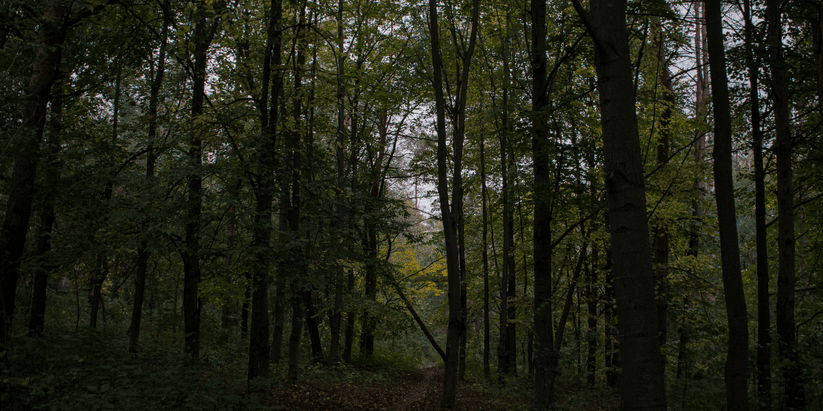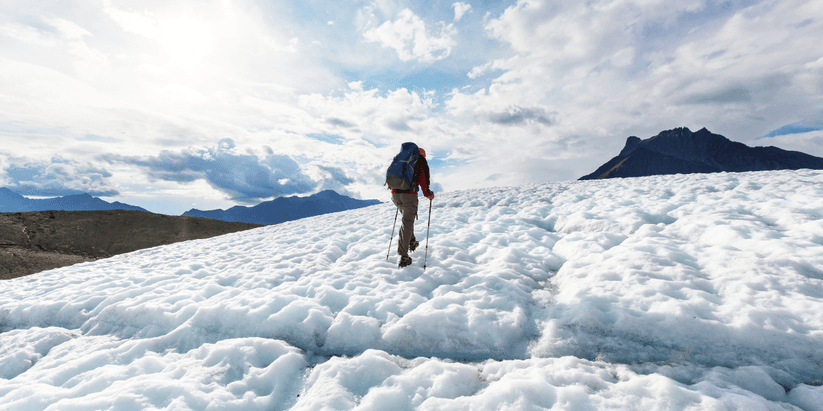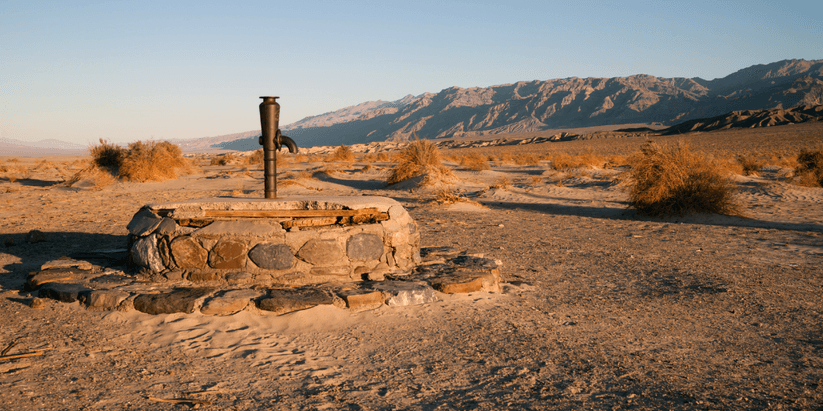31 October, 2022
We are spotlighting 5 of the scariest and hardest races in the world. Which race would you be brave enough to take on?

We have just posted a new article talking about 5 more of the scariest ultra marathons in the world, click here to read once you have been through these races.
The Marathon Des Sables, dubbed the 'toughest footrace on earth', is a 6 day long ultra marathon located in the Moroccan Sahara Desert. Over the 6 days participants aim to travel 156 miles (251km), which is the distance of six regular marathons, with the longest single stage is 57 miles (91km).
The idea for the ultra marathon began around 1984 when Patrick Bauer decided to make for the Sahara to try to traverse a 350km expanse of uninhabited desert, on foot, alone, where he wouldn’t come across a single village, oasis or watering place. Totally self-sufficient, with a rucksack weighing 35kg and containing water and food, he set off on a journey which was to last 12 days. It was the starting point of what was to become the Marathon Des Sables. The ideation became a reality in 1986 as 23 pioneers who took the start never imagined that their footprints would mark the start of a legendary event, which today has become unmissable on the schedule for major adventure sport meets.
Would you be able to handle the heat of the Marathon Des Sables
What makes the race even more grueling, aside from the 50 degree heat and undulating course, is that each participant must carry his/her own backpack containing food, sleeping gear and other material. A variety of runners have traveled to take on the infamous race with the youngest competitor being 16 and the eldest marathon participant being 83. Participants of the race have recalled the difficulty of travelling through thick sand, which requires runners of the ultra marathon to tie plastic bags to their feet to limit the sand entering their trainers. Stepping into the sand feels like taking one step forward and half a step back as a result of the softness of the sand beneath their feet.
Acclimatising to the heat of the location is said to be one of the hardest elements of the ultra marathon. In the 2021 installation of the Marathon Des Sables, the third death in the events 35-year history was recorded and almost half of the race competitors failed to cross the finish line which is the highest drop out rate of the races history, with the usual rate floating between 5% and 10%.
Runners can enter the race by the Marathon Des Sables official website via the registration page. The cost of entry for the event is €3,190 for an individual entry and €3,290 per team member for teams.
Think you can take it on? Head to the website to find out more.

The Barkley Marathons... the race which eats its young... the race where dreams go to die. The Barkley Marathon was created by Gary 'Lazarus Lake' Cantrell and Karl Henn. The idea for the race was inspired upon hearing about the 1977 escape of James Earl Ray, the assassin of Martin Luther King Jr., from nearby Brushy Mountain State Penitentiary. Ray covered only about 12 miles (19 km) after running 54.5 hours in the woods hiding from air searches during the day. Cantrell said to himself, "I could do at least 100 miles," mocking Ray's low mileage. Thus, the Barkley Marathons was born.
Participants in the event must negotiate the most extreme of terrains and climates, with accumulated ascents of over 50,000 feet. 35 'lucky' runners are able to start the event each year with each entrant having to submit an essay explaining why they should make up one of the 25. Event more obscurely, the entry fee is $1.60 and successful entrants are sent a 'letter of condolence.
A famous prison escape sparks the idea for a cult-like race that has seen only 15 finishers in its first 30 years
The course itself, which has changed distance, route, and elevation many times since its inaugural run, currently consists of an approximate 20-mile (32 km) unmarked loop with no aid stations except water at two points along the route. The loop begins and ends at the yellow road gate where the runners' and supporters' parked cars stay. Runners of the 100-mile version run this loop five times, taking a counterclockwise direction for loops two and four, followed by each runner alternating direction on loop five, after the first-placed runner's choice. Depending on the start of the first loop, either the second and fourth loops are run at night, or the first, third, and fifth loops are run at night. Runners who complete three circuits of the loop (60-miles) are said to have completed a "fun run".
The start of the ultra marathon can start any time from midnight to noon of the race day with a conch being blown an hour before the start. Competitors must find between 9 and 14 books along the course (the exact number varies each year) and remove the page corresponding to the runner's race number from each book as proof of completion. Competitors get a new race number, and thus a new page requirement, at the start of each lap.
The cut-off time for the 100-mile race is 60 hours overall, or an average of 12 hours per loop, and the cut-off for the 60-mile version of the race is 40 hours overall, which averages out to approximately 13 hours and 20 minutes per loop. Once a competitor has started a loop they are not allowed to receive any assistance, other than from fellow runners, until they have finished that loop.
The difficulty of the Barkley Marathon is made clear by the amount of finishers the race has actually had. Since the start of the ultra marathon, over 1,000 runners have set off with high hopes, yet only 15 have finished, with many of the years ending without a finisher. The most recent winner was ultra marathon legend, John Kelly, who finished the course back in 2017. Only two individuals have completed the event more than once. Brett Maune finished the Barkley in consecutive years - 2011 and 2012, and Jared Campbell has completed the ultra three times, in 2012, 2014 and 2016.
There are some fantastic documentaries that cover the event with some of the worlds best ultra marathon runners:
- Where dreams go to die - Gary Robbins
- Out there - Karel Sabbe
- The race that eats its young

We started with heat in the Marathon Des Sables, to the tricky landscape of the Barkley Marathons, and now we arrive at the other side of the scale...Ice. Ice Ultra is a trial of strength for the hardy. 230km (143 miles) on foot in February, through one of Europe's perhaps most mythical mountain landscapes. During a few days in February extreme athletes challenge their limits by walking 230 kilometers through the Arctic mountain landscape, mainly through World Heritage Laponia. Ice Ultra is, without doubt, a trial of strength for the hardy, and one of the absolute toughest ultra-marathon challenges out there.
This is one of the world’s toughest ultra races and extreme athletes from all around the world participate. They run – with and without snowshoes – through the Arctic mountain landscape, over wind-packed snowfields, frozen lakes and through mountain forests. They sleep in tents or in mountain huts they pass along the route
Participants endeavor to complete 5 stages of the ice race, over the span of 5 days. No matter whether it is day or night, the temperature sticks at around -40 degrees centigrade with only 8 hours of daylight for participants to use and navigate the terrain of snowfields and arctic tundra. The Red Jersey stage of the ice ultra marathon features a 15km frozen lake... watch your step!
Competition rules are rigorous and no compromises are made on the packing requirements. Lacking a safety kit, itemised down to the smallest tweezers, a number of plasters and sterile compresses is a reason for disqualification. Even calorie intake is regulated.
Those who eat less than the stipulated 2,000 kcal per day can count on a time penalty of up to three hours. Leaving rubbish behind or asking for assistance is directly disqualifying.
Entering the Swedish Ice Ultra will set you back £3,300 per athlete, if you fancy a go. At the time of writing this there are 8 places remaining... If you envisage an ice-based challenge, you can fin out more information on the 'beyond the ultimate' website.

Just like that, we are back to the sun with Badwater 135, a race describes as being like 'running on the sun'. Covering 135 miles (217km) non-stop from Death Valley* to Mt. Whitney, CA, the Badwater® 135 is the most demanding and extreme running race offered anywhere on the planet, as well as the 135-Mile World Championship. The start line is at Badwater Basin, Death Valley, which marks the lowest elevation in North America at 280’ (85m) below sea level. The race finishes at Whitney Portal at 8,300’ (2530m), which is the trailhead to the Mt. Whitney summit, the highest point in the contiguous United States.
The event 'boasts' a cumulative vertical ascent of 14,600 feet (4450 meters) and over 6,100 feet (1859 meters) of cumulative descent which spans over 3 mountain ranges in a location which is notoriously the hottest place on earth. Fun fact, Death Valley holds the record for the highest air temperature on the planet: On 10 July 1913, temperatures at the aptly named Furnace Creek area in the California desert reached a blistering 56.7°C (134.1°F). Average summer temperatures, meanwhile, often rise above 45°C (113°F).
Don't know what Badwater 135 is? Here is a quick look at 2017's Badwater 135.
Competitors travel through places or landmarks with names like Mushroom Rock, Furnace Creek, Salt Creek, Devil’s Cornfield, Devil’s Golf Course, Stovepipe Wells, Panamint Springs, Darwin, Keeler, Lone Pine, Alabama Hills, and the Sierra Nevada.
According to some runners that have taken part in the hostile ultra marathon, they are forced to run on the white separation lines of the road as the tarmac is incredibly hot and has been known to melt the bottom of running shoes.
So how did the horrible race come to be? The first hikes across Death Valley of more than 100 miles took place in 1966, starting with Jean Pierre Marquant of France. Hikes between Badwater and Mount Whitney were first made in 1969 by Stan Rodefer and Jim Burnworth of San Diego. Al Arnold first attempted running the route in 1974 but was pulled off the course after eighteen miles (29 km) with severe dehydration. After vigorous sauna-training and desert-acclimatization, he attempted the run again in 1975. This time, a knee injury aborted the run at fifty miles. In 1976, training injuries kept him from even beginning his annual attempt on the course.
In 1987, the crossing became an official, organized footrace. Five runners competed the first year. During the early years of the race, no particular route between Badwater and Whitney was specified and runners attempted various "shortcuts" between the start and finish. Adrian Crane, one of the competitors in the inaugural race, even used cross-country skis to cross the salt-flats at Badwater. In 1988 the race was called the Badwater 146 because the finish line was the summit of Mt. Whitney. Later it became Badwater 135 since it was not permissible to have an organized competition on national park land.
The course record in the male category is currently set by Japanese ultra runner, Yoshihiko Ishikawa, who completed the course in a staggering 21:33:01 back in 2019. The current female record setter, is Ashley Paulson, an American athlete who set an incredible time of 24:09:34 in the most recent episode of Badwater 135. Amazingly, the eldest ever finisher of Badwater is UK legend, Jack Denness who, at 75 years old, completed the ultra marathon in 59:13:02. The race actually had a 48-hour cut-off for a buckle, but allowed up to 60 hours for a medal.
In the 90's the course averaged around 20 starters, however the notoriety of Badwater 135 has meant that in the modern era, just short of 100 individuals test themselves each year with around 80% of starters managing to complete the course in the 48 hour cut off.
If you want to test yourself in the heat and want to find out more, head to the Badwater 135 website.

An event called the Dragon's Back ultra... pretty scary right? Last, but certainly not least, we travel to the world's toughest mountain race, located in Wales. The Dragon's Back Race is a multi-stage ultra marathon with a distance of 380km (236 miles) split into 6 days of running. Every evening there is a new ‘pop-up’ overnight campsite where you will get hearty afternoon snacks, dinner, and breakfast, catch up with fellow participants, have access to the race medics, and crucially get a good night’s sleep in tented accommodation.
The route is not marked on the ground - so you will be required to navigate using a GPS device and/or map and compass. This event has been designed so that it is possible to complete it by following the GPS track. However, even if you are navigating using a GPS device, it is mandatory to carry at all times the Harvey Maps 1:40 000 scale event map that is supplied at registration.
The legendary multi-stage, ultra running journey down the spine of Wales.
The race begins on the north coast of Wales and ends on the very south coast. Participants must navigate their way through treacherous and challenging locations such as the Elan Valley and Brecon Beacons.
The race was previously over five days with a significant distance of 186 miles (299 km), as opposed to the 2021 length of 236 miles (380 km).
In August 2020 the organisers, Ourea Events, released the news that the 2021 edition of the race would mark a step change in the evolution of the event with the addition of a sixth day, which would see the race finish at the iconic Cardiff Castle.
To give you an idea of how long it takes to finish the race, the times of the 2021 winners are as follows. Simon Roberts lead the men's category with a time of 45:42:11, whilst Katie Mills finished top spot in the women's category finishing in 61:12:54. An outrageous period of time, and to think, they were the fastest!
In totality, the cumulative ascent of the race would add up to twice the height of Mount Everest, which may play a part in the ultra marathon being named the world's toughest mountain race.
As with the other events, if you want to try this out yourself, you can find out more information on the Dragon's Back Race website. This race actually comes in a bit cheaper than the ones above, at a reasonable £1,599 for the pleasure of putting yourself through hell!

Hi! I'm Dom and I am the Digital Communications Manager at Outside & Active. I manage the content and marketing for this site and sometimes document my experiences and thoughts. I absolutely love to be outside and active in any way possible.
I have been playing all varieties of sports since the age of 5 but in the past few years I have somehow become a 'runner'. This has opened my eyes to a whole new world of adventure, I still love playing team sports and heading to the gym - but managing this website has helped me explore different ways to enjoy the outdoors.
Most recent articles by Dominic Brown

Global Running Day is a call to millions of runners around the world, no matter how far or fast you go. Celebrated on the first Wednesday of June, this event isn’t just for athletes; it’s for everyone seeking to embrace a healthier lifestyle through running.

I recently visited the recently opened Parthian Climbing Centre in Wandsworth to try out their world class climbing experience. Having not climbed for over 15 years, this is my review of how it went...

Looking for a new piece of inspiration or entertainment during your morning commute or exercise. Here are is list of 5 podcasts that are sure to get the adventure juices flowing.
Most recent articles in ADVENTURE

Want to meet up with like-minded adventurers, try some new activities and get inspired? Try these festivals in the UK.

In January 2024 I left my home in Manchester to travel around South East Asia. Running has played a huge part in my experience of each and almost every place I’ve passed through. But this type of behaviour hasn’t always been typical of me. No, in fact a couple of years ago, I’d have thought it bizarre to even think of running whilst on the trip of a lifetime, let alone actually follow through with it and worse still, enjoy it!

Universal Pictures Content Group and Dogwoof announce THE MOUNTAIN WITHIN ME will release in UK cinemas on 23rd August 2024, preview Q&A screenings will tour the country from 19 August 2024.